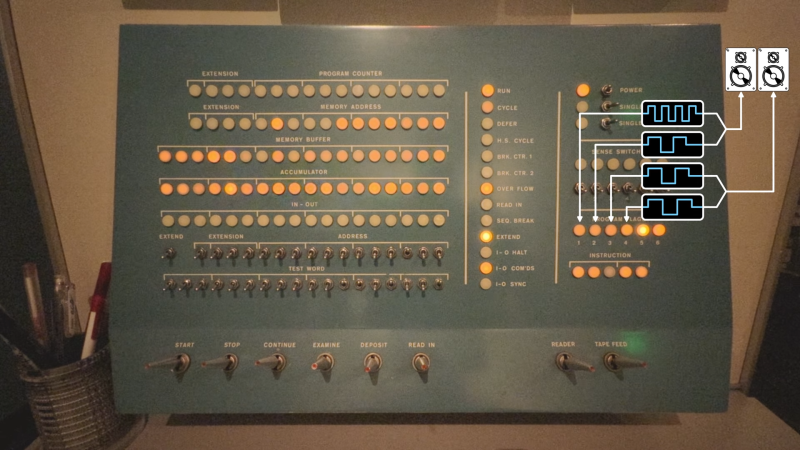The chiptune music scene is largely rooted in the sounds of the original Nintendo Game Boy and the Commodore 64, while still welcoming a wide range of other hardware under its general umbrella. Still, few chip musicians show up to a gig hauling a PDP-1. That’s perhaps a shame, given that the 1950s era machine can produce beautiful music—as demonstrated by [Peter Samson] and [Joe Lynch].
The video demonstration was recorded at the Computer History Museum in Mountain View, California. [Peter Samson] is operating the PDP-1, which is running the Harmony Compiler—which allows the machine to play four individual voices. This is achieved by taking advantage of the PDP-1’s program flags, which are visible as six light bulbs on the control panel. Instructions can be used to turn these bulbs on and off. The Harmony Compiler works by switching the bulbs on and off fast enough to create audible square waves when the light bulb outputs are wired to a simple audio amplifier.
Using Harmony Compiler, [Joe] and [Peter] worked together to transcribe the song Olson by Boards of Canada to play on the PDP-1. The song is encoded on paper tape, and fed into the machine—which dutifully plays back the hauntingly beautiful melody.
If you’re interested in the code that achieved this, it’s blessedly available via Github. If you love stories about old computers playing music, we’ve got those too. Video after the break.
[Thanks to Stephen Walters for the tip!]
















What a delight full sound for this song, it adds so much magic. And what a lovely piece of equipment, especially that X,Y display showing the signal/voices.
I think that the X,Y display is showing a different and unrelated program called “Snowflake”.
I have a DEC VAX 750 and a VAX 730. AND a CDC 300 MB a washing machine size drive. Digi Data real to real tape drives,. COMPLETE! DEC LA36 printer, with upgraded board. See AE6JI at FCC data site (amateur ham radio call sign) write an actual LETTER TO ME, IF
INTERESTED. LARRY H.
As I write this, I’m in the process of rejuvenating an SGI Iris Indigo.
Those paper tapes bring back some memories. We had the remnants of a PDP-1 (I remember the CRT and the IBM typewriter) in the lab at UMASS/Amherst, iwhen I was a student there in the 70s. It was in pieces then, but some of the module mechanical parts were being used for projects, as the connectors plugged into our EL Industries breadboards.
Beautiful sounds from early digital era.
This has long been one of my favorite instances of that – it’s an IBM 7094 mainframe playing and singing “Daisy Bell”, back in 1961.
https://www.youtube.com/watch?v=41U78QP8nBk
Reminds of early MIDI music.
I read about that recently. Nice to see it in action!!! I recently built the PiDP-1 front panel for fun. Going to be fun to work with I think. Be nice to have a tape reader instead of the virtual one… but hey, can’t have everything for the bygone era!
That sounds amazing. Much better than the 8080 program that would play music through the interrupt enabled status line.
That was amazing, genuinely surprised how good it sounds.
Real incandescent lamps on the panel! Yay! 🩶